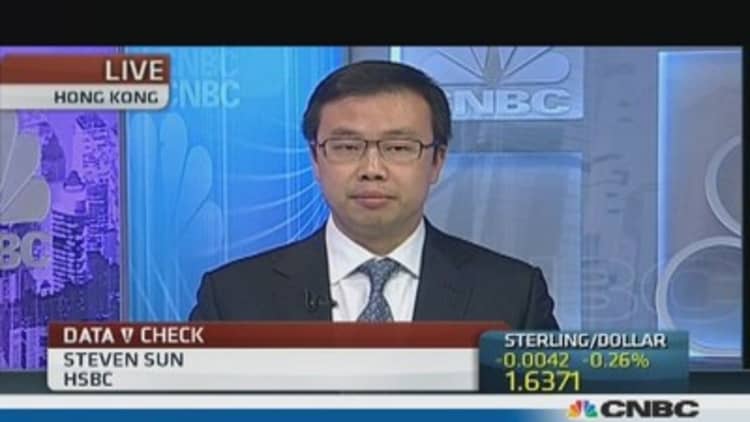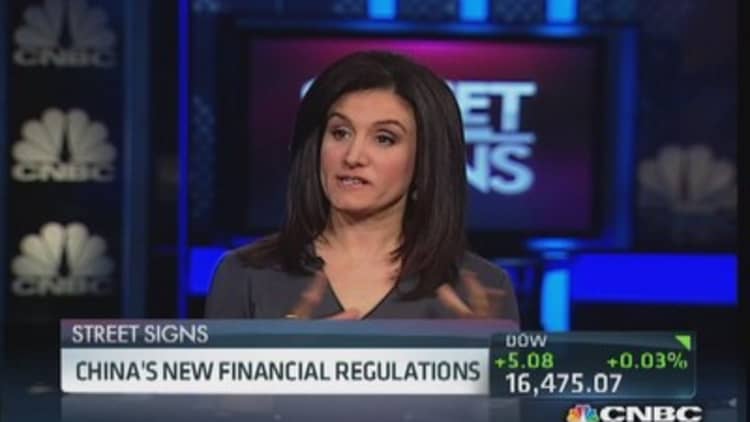China's central bank looks set to risk another cash crunch at the end of January, barely a month after the last market squeeze, as policymakers press ahead with a crackdown on shadow financing and other risky bank lending.
The People's Bank of China (PBOC) is attempting a delicate balancing act to keep economic growth on track while avoiding a debt-induced financial crisis.
(Read more: China 'major' uncertainty facing global economy: Soros)
Periodic cash squeezes as banks scramble for fresh funds highlight the policy dilemma the PBOC faces in 2014, as it pushes financial reforms to help rebalance the world's second biggest economy away from the investment- and exports-led model that powered its rapid rise.
Spikes in June and December in the interest rates at which banks lend to each other signaled the central bank's determination to reduce alarming levels of debt. But it must try to do so without hurting growth by braking too hard on credit.
"It's difficult for the central bank to implement monetary policy," said Liang Youcai, senior economist at the State Information Center, a top government think-tank in Beijing.
"Monetary policy may be slightly tight in 2014 but the central bank has to consider the impact on the real economy."
Demand for cash is strongest near the end of each quarter as banks rush to meet regulatory requirements, such as loan-to-deposit and reserve ratios, and pay out maturing financial products - a factor that fueled both episodes in 2013.
Analysts say the seasonal liquidity strain in money markets could re-emerge when demand for cash from firms and depositors spikes ahead of the Lunar New Year holiday at the end of January. Banks also tend to increase lending at the start of the year, while the resumption of IPOs after a year-long freeze could also increase demand for cash.
(Read more: Time to get picky on China stocks: HSBC)
Market volatility
The central bank mostly stood by as interbank lending rates grew more volatile in 2013, and was accused of worsening June's market turbulence by keeping the purse strings too tight.
Since then it has sought to improve its communication with the market - including by announcing its short-term liquidity operation (SLO), by which it injects funds into the banking system, via its new account on the microblogging platform Weibo.

But analysts do not expect a fundamental shift in the PBOC's approach - it will continue to nudge the markets into pricing short-term wholesale funding less attractively, while injecting enough cash into the banking system during periods of strain to avoid a full-blown crisis.
President Xi Jinping and Premier Li Keqiang need to keep economic growth humming to consolidate their power base as they try to forge ahead with sweeping economic and social reforms unveiled late last year.
Sources at top government think tanks have told Reuters that for 2014, China will likely stick with last year's annual economic growth target 7.5 percent.
China's economic growth is likely to come in at 7.6 percent in 2013, the government has said, just above the official target and slightly below 7.7 percent in 2012.
(Read more: China cash rates jump on liquidity worries)
In a New Year's Eve statement after a regular monetary policy committee meeting, the central bank pledged to maintain appropriate liquidity and achieve reasonable growth in credit and social financing, while improving and credit structures.
Cash crunch
The central bank aims to target short-term interest rates, such as the Shanghai interbank offered rate (SHIBOR), to manage bank liquidity and credit, reducing the reliance on ad hoc controls such as adjusting banks' loan-to-deposit ratios.
But the money market turbulence shows such a transition could be risk-prone and take time.

"The traditional controls on credit are becoming less effective, while the interest rate transmission mechanism has yet to be established, This is a challenge for the PBOC," said Xu Gao, chief economist at Everbright Securities in Beijing.
"If you control the price (of credit), you cannot control the volume; if you control the volume, you cannot control the price."
The central bank will likely make measured use of policy tools such as SLO, or reverse repos - in which banks temporarily swap fixed-income securities for cash - to help lenders weather sporadic cash strains this year, analysts say.
Rising money market rates have trickled down to bond yields, but the impact on bank lending has so far been limited.
(Read more: Marching higher once more: China cash rates)
Shadow banking
China's cabinet has issued new guidelines to strengthen regulation of so-called shadow-bank lending that has fuelled an explosion in debt levels in recent years.
The PBOC hopes that higher money rates will ultimately force banks to cut their risky lending, but for now demand for loans and other forms of financing from the state firms and local governments that suck up the bulk of funding remains strong.
Shadow banking, which includes trust loans, bank acceptance bills and underground lending, has grown rapidly in China since 2010, and many bankers say it was partly to blame for the interest rate spikes in June and December.
Chinese banks have rushed to issue short-term, higher-yielding wealth management products to skirt the rigid regulatory control on credit, but still channel the funds into long-term investment projects. When redemptions on such products fall due, banks have to raise funds in the interbank market.
(Read more: Inside China's $6 trillion shadow banking system)
Calls for China to accelerate financial and fiscal reforms grew louder last week after figures showed its indebted local governments owe nearly $3 trillion in a debt build-up that some analysts called alarming.
Fiscal reform is all the more urgent as a lack of constraint on the finances of heavily indebted local governments will make interest rate reform less effective. A bigger slice of tax revenues would reduce their need to borrow heavily or to sell land to raise revenues.
Cautious reform
The central bank is keen to embrace market-driven interest rates to help wean the economy off its reliance on investment, but analysts say it has to consider the structural constraints and potential risks.
The banking regulator - China Banking Regulatory Commission - has been more cautious over the pace of interest rate liberalization than the central bank for fear of fuelling banking risks, sources familiar with the policy debate say.
The central bank, which removed controls on bank lending rates in July, will have to tread more warily in freeing up the long-depressed deposit rates, which could rise immediately and push up borrowing costs, analysts say.
(Read more: China unveils boldest reforms in decades, shows Xi in command)
That could hurt manufacturers that are already operating on thin margins due to the yuan's steady appreciation and rising wages.
"They need to choose the right timing. I don't think they will free up bank deposit rates when they are under pressures to rise," said Lu Zhengwei, chief economist at Industrial Bank in Shanghai.
The central bank is likely to unveil a long-awaited deposit insurance system in early in 2014 to pave the way for freeing up bank deposit rates, analysts say.
The insurance scheme would protect depositors as Beijing is concerned some smaller lenders could go under as banks compete for deposits in a more open regime.
(Read more: China's economic reforms: What you need to know)
Analysts expect the central bank to gradually lift the ceiling on bank deposit rates - from the current 110 percent of the benchmark, rather than freeing up the rates in one stroke.
"Reforms are clear but will not be very quick. The whole reform process may not be completed in three years," said You Hongye, an economist at Essence Securities in Beijing.

